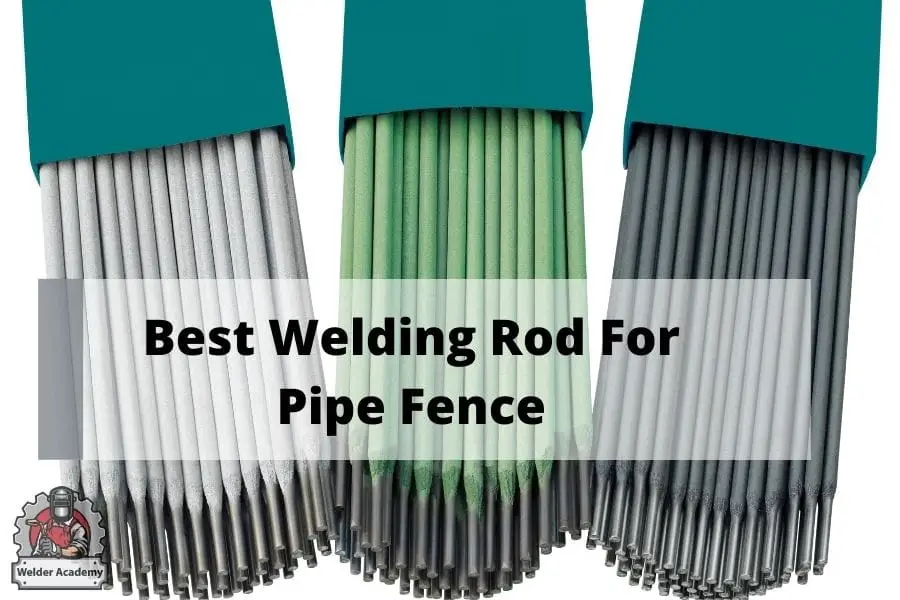Welding on a pipe fence is a time-consuming process. It takes a lot of time to get all the insertions and lids welded down. You also need to weld with high amperage and use the proper welding rod depending on the condition of the pipes. I’m guessing you are here to sort this stuff out and learn what is the best welding rod for pipe fences.
6010 and 6011 are both decent options for old oil pipes. They provide a decent penetration even on rusted pipes. But you would get more benefits from 7018 if you use new ones. The 7018-welding rod is stronger and has a cleaner finish.

This is the best welding rod for pipe fences, under the condition that you are using brand new pipes. 6010 and 6011 are both better for working with damaged or rusted pipes. Stay away from 6013 though. These rods are only worthwhile for flat welding on thin metal. I will explain how to choose welding rods depending on the situation in the following sections.
Choosing The Right Rod For Pipe Fence
You would often see pipe fences in ranches, and many people know how to set them up. People typically need different welding rods based on the overall condition of the pipes. Most people use oil field pipes, which are typically made out of steel.
Here is the List of welding rods you can use:
6010 Welding Rod
Ok, so the 60 in the number represents the strength of the weld, which is 60 thousand pounds in this case. The 3rd digit represents which position the rod is good for. 1 means it is suitable for horizontal, vertical, and overhead, which covers pretty much all the weldable dimensions.
You always need welding rods that are good for all directions while welding any kind of pipe because of their circular shape. The last number signifies the type of coating on the rod. 0 means a high cellulose sodium coating, which offers a smooth arc under average amperage. But remember, it only works with a DC+ or DCEP power unit.
6010 is the most common type of welding rod used on oil pipes. Most people use factory-reject pipes or old pipes with impurities for this kind of project. The 6010 can handle impure welding material due to its high penetration range. It can also put root beads inside the pipe without too much effort.
These rods are also very fast-freezing, so you can avoid getting the pipes too hot as long as you are a bit careful. I do suggest not using too high an amperage with this one because that will cause burns and splatters.
6011 Welding Rod
The 6010 and 6011 have very similar characteristics. They both have the same tensile strength and are suitable for all positions. The difference lies in their coating. The 6011 welding rod uses a high cellulose potassium coating, so it has relatively better penetration on fence pipes compared to the 6010.
The coating allows it to have a spray-type arc, which goes deep inside the metal layer. It works well on rusty or contaminated oil field pipes. You can also use them on older pipes that have been sitting around for a while. You can weld magnetized pipes with it too, but you would need to use DC+ welding current. It will be a bit tricky though.
6011 is very forgiving on the power requirement. It works fine with AC, DC+ or DC-. The arcs on AC welding current are easier to handle, but you can do more with DC after getting the hang of it.
7018 Welding Rod
7018 is the conditional best welding rod for welding pipe fences. It provides unparalleled smoothness and polish on the weld. The overall weld finishing of 7018 is much better compared to 6010 and 6011 while also having higher tensile strength.
This rod has low hydrogen potassium or iron powder coating. The special characteristics of this sort of coating allow it to achieve a smooth finish. You will face hardly any weld splatters while using this welding rod. It has mild penetration on carbon steel. It works on AC, DC+, or DC- welding currents.
7018 is not a fast-freezing weld, so the molten metal can drop before it finishes cooling. That gets very noticeable when working on rust or corroded metal with too much impurity. This is partly why most people avoid using it on older oil pipes. The 6011 and 6010 are both better for working with corroded pipes than 7018. Most people use it strictly for brand new pipes.
Which Welding Rods To Avoid For Pipe Fences?
6013 is a newbie trap that’s why I’m mentioning it here as a warning. One of the most common mistakes beginner welders make is substituting 6013 for 6010 or 6011 rods. Don’t get me wrong, it is a fantastic all-purpose welding rod that everyone uses from time to time, but it just is not fit for welding thick pipes.
It is a mild steel rod with a high titania potassium coating. It cannot handle high voltage but works fine in the lower amperage. The 6013 arc has a relatively shallow penetration range, which is also why it is not suited for welding pipe fences. The mild penetration is only suitable for workpieces such as sheet metal.
There is also the 7028-welding rod that you should avoid for this kind of project. This is very powerful and can easily melt your fence beyond the level you are looking for. People mostly use it for industrial-grade projects.
Tips For Welding Pipe Fence
Welding pipe fences can be a tricky job. So, here are some bonus tips to help you avoid costly mistakes when welding your pipe fence:
Prep The Joint Before Welding
Pipe fences are, almost exclusively, made out of steel pipes. The factory rejects, and old rusty pipes are more common than brand new ones, as they get the job done at a lesser cost. 6010, 6011 can both penetrate rust, but you should still sand the rust off as much as possible. Excessive rust will make it harder to apply the
Poorly cut holes will affect the integrity of the fence. You might need to put in extra filler metal to compensate for bad workmanship. But extra filler metal might cause weld distortions, which will result in you doing more cleanup work.
Set up Right Amperage
Getting the right amount of energy for the weld is necessary for good finishing. The 6011 cannot handle high amperage, so it will cause extra splatters if you crank up the power above 105 amps. 7018 is better at handling high amperage and will do poorly on lower amps.
6011 will have less slag but the overall quality of the weld will be less than pretty. You should expect to see some ugly burns and weld drips on the joints if you use a 6011 with too much power.
Magnetized pipes can be a bit tricky to work with, you need to research what welding current to use and how to degauss them. You will need to select DC+ or DC- depending on the polarity of the magnetized metal. AC is much better in this regard, as it has fewer restrictions when degaussing metal.
Conclusion
I suggest going with 6011 if you are a complete beginner and don’t know much about what you are doing. This is the best welding rod for pipe fences, in general. The 6010 and 7018 are good for certain situations, but they are harder to work with and come with a lot of restrictions.
Thanks for tuning in and I hope this article was helpful to you.



